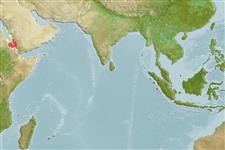>
Eupercaria/misc (Various families in series Eupercaria) >
Labridae (Wrasses)
Etymology: Minilabrus: Latin, minimus= smallest + Greek, labros = voracious (Ref. 45335).
More on authors: Randall & Dor.
Environment: milieu / climate zone / depth range / distribution range
Ecología
marino asociado a arrecife; rango de profundidad ? - 12 m (Ref. 9710). Tropical
Western Indian Ocean: known only from the central and southern portions of the Red Sea.
Tamaño / Peso / Age
Maturity: Lm ? range ? - ? cm
Max length : 6.0 cm TL macho / no sexado; (Ref. 9710)
Found in aggregations above outer reef slopes. Feeds on zooplankton.
Life cycle and mating behavior
Madurez | Reproducción | Puesta | Huevos | Fecundidad | Larva
Oviparous, distinct pairing during breeding (Ref. 205).
Lieske, E. and R. Myers, 1994. Collins Pocket Guide. Coral reef fishes. Indo-Pacific & Caribbean including the Red Sea. Haper Collins Publishers, 400 p. (Ref. 9710)
IUCN Red List Status (Ref. 130435)
Threat to humans
Harmless
Human uses
Más información
Age/Size
Crecimiento
Length-weight
Length-length
Length-frequencies
Morfometría
Morfología
Larva
Dinámica larvaria
Reclutamiento
Abundancia
BRUVS
ReferenciasAcuiculturaPerfil de acuiculturaRazasGenéticaElectrophoresesheritabilidadEnfermedadesProcesamientoNutrientsMass conversion
ColaboradoresImágenesStamps, Coins Misc.SonidosCiguateraVelocidadTipo de nataciónSuperficie branquialOtolitosCerebrosVisión
Herramientas
Special reports
Download XML
Fuentes de Internet
Estimates based on models
Preferred temperature (Ref.
123201): 28.6 - 29.3, mean 29.1 °C (based on 81 cells).
Phylogenetic diversity index (Ref.
82804): PD
50 = 1.0000 [Uniqueness, from 0.5 = low to 2.0 = high].
Bayesian length-weight: a=0.00501 (0.00207 - 0.01214), b=3.15 (2.94 - 3.36), in cm total length, based on LWR estimates for this (Sub)family-body shape (Ref.
93245).
Nivel trófico (Ref.
69278): 3.4 ±0.45 se; based on food items.
Resiliencia (Ref.
120179): Alto, población duplicada en un tiempo mínimo inferior a 15 meses (Preliminary K or Fecundity.).
Fishing Vulnerability (Ref.
59153): Low vulnerability (10 of 100).
